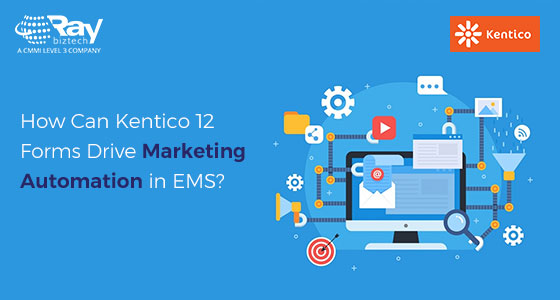How Can Kentico 12 Forms Drive Marketing Automation in EMS?

Forms serve as one of the vital components of any CMS application. Users can leverage Kentico EMS to drive marketing automation process using dynamic forms. Through a well-defined approach to automate the process, forms can play a crucial role in savings costs, optimizing resources, and help enterprises achieve productivity with marketing automation.
An aggressive marketer would aim at reaching the largest audience in an effective manner. Forms can be designed to create and execute powerful processes to drive marketing automation as part of the Kentico EMS framework. This involves tools to extract information from a user through a form, by addition of suitable triggers and completing required actions by executing the relevant piece of code.
Various built-in capabilities allow marketers to automate their marketing function with the number of steps desired. This also allows enterprises to work with their own set of business rules pertaining to data collated through forms. Coding experts could play with custom macros and dynamic values to set the order of precedence of form controls and its associated call actions.
Let us now create a sample custom form with typical fields, set up ‘Send an email’ through the UI, then add a trigger to detect a ‘contact’ activity, and test the forms’ activity in the underlying environment.
Creating a Form
Define a basic form with all the regular fields a user must fill in. Add special fields for posting a ‘Status’ and ‘Phrase’ to be duly submitted by the user of the site.
Initiating the Automation Process
Here, a developer can apply business rules framed by default under the robust Kentico CMS engine in order to make their forms dynamic – so that the Admin does not have to manually send an email to contact the potential buyer.
‘Send the email’ functionality
Create a new process to send out an e-mail inside the ‘admin’ UI. Once this is functional, the administrator is notified that a form has been submitted. The e-mail address of the recipient is dynamically extracted from the submission screen.In order to take into account the time lapse between form submission and the e-mail trigger, a‘wait’ time might be set in terms of the desired number of seconds. An explicit ‘wait’ is not typically required in Kentico 12 Forms, as those actually have a built-in delay notification for such a purpose.
Addition of Trigger
A built-in trigger ‘Contact performed an activity’ – classified as a specific ‘form submission’ activity - is added in order to confirm a contact has performed an activity. This will actually consolidate the entire process and realize the marketing automation objective where in the trigger instantly executes a well-defined process for each and every visitor who fills in a form on the website.
Testing
Test the entire procedure using a dummy form submission to check all the aspects of forms’ functionality, as well as whether data has been captured. Any bottleneck issues with the forms are mostly tracked and fixed with load testing as well as debugging performed by the concerned software testing personnel.

